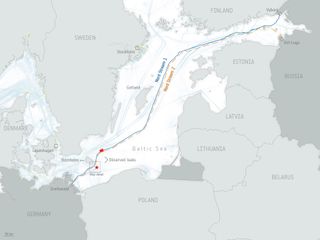Satellite images reveal the scale of Nord Stream gas pipeline leak
'The Nord Stream release is roughly equivalent to one and a half days of global methane emissions.'

Multiple satellites observed as hundreds of tons of methane bubbled up from the damaged Nord Stream 1 and 2 pipelines last week, turning parts of the sea between Denmark, Sweden, Poland and Germany into a giant jacuzzi.
Thosesatellites returned a bit of good news, confirming that the amount of climate-warming methane that escaped from the pipelines into the atmosphere was relatively small compared to overall annual emissions.
Satellites operated by the European aerospace giant Airbus and those of the U.S. Earth-observation specialist Planet imaged the leak in the Baltic Sea pipelines that used to carry natural gas from Russia to Europe a few days after the four ruptures first began spewing climate-warming methane on Sept. 26. The incident captured the world's attention, because it's widely believed the damage resulted from sabotage — perhaps by Russia as part of Vladimir's Putin revenge against the West for sanctions imposed as a response to Russia's invasion of Ukraine.
Related: Satellites discover huge amounts of undeclared methane emissions



Later, satellites of the European Copernicus Earth-monitoring program, as well as those of NASA's Landsat program, saw the amount of sea foam around the four leaks decrease as the pipelines, which weren't actively supplying gas at the time of the damage, vented out most of the methane that had been left in them. Radar satellites of the Finish company ICEYE also detected the "sea roughening" caused by the methane bubbles stirring up the sea water.
Perhaps the most revealing measurements were made by Canadian firm GHGSat, which precisely estimated the amount of the greenhouse gas leaking into Earth's atmosphere.
Last week, GHGSat said that 174,000 pounds (79,000 kilograms) of methane were escaping every hour from one of the holes in the Nord Stream 2 pipeline, in what the company described as the largest single methane leak ever measured by their satellites. The emissions, the company said in a statement, were equivalent to more than 2 million pounds (0.9 million kg) of coal being burned in one hour.
Get the Space.com Newsletter
Breaking space news, the latest updates on rocket launches, skywatching events and more!
"What our satellites observed is a significant emission coming from one of the four leaks in the Nord Stream 2 pipeline and underscores the critical role technology can play in a crisis situation," Stephane Germain, founder and CEO of GHGSat, said in the statement.

Europe's Sentinel-5P satellite, part of the Earth-monitoring Copernicus constellation, also had a go at assessing the scope of the leak. The European Space Agency, which develops the Copernicus satellites for the European Union, said in a statement that the emissions from the leak were a drop in the ocean when compared to the annual emissions of the global oil and gas industry, which equal 80 million metric tonnes.
"[The Nord Stream] release is roughly equivalent to one and a half days of global methane emissions," ESA said in the statement.
Some 300,000 tonnes of methane are believed to have been trapped in the dormant pipelines at the time of the leak. According to the Danish Energy Agency, the leak stopped on Sunday (Oct. 2). GHG Sat satellites didn't detect any emissions after Oct. 3 during their follow-up measurements, the company confirmed.
Methane, while responsible for only 20% of global greenhouse gas emissions, according to the U.S. Environmental Protection Agency, is more than 25 times more warming than the more common carbon dioxide.
Experts agree that a large portion of methane emissions is preventable as the gas frequently leaks from pipelines, oil and gas processing plants and landfills. At the COP26 climate change conference in Glasgow last year, world leaders committed to slashing methane emissions by 30% by the end of this decade. According to the European Commission, getting methane emissions in check could reduce the projected atmospheric warming by 0.5 degrees Fahrenheit (0.28 degrees Celsius) by 2050.
Follow Tereza Pultarova on Twitter @TerezaPultarova. Follow us on Twitter @Spacedotcom and on Facebook.
Join our Space Forums to keep talking space on the latest missions, night sky and more! And if you have a news tip, correction or comment, let us know at: community@space.com.

Tereza is a London-based science and technology journalist, aspiring fiction writer and amateur gymnast. Originally from Prague, the Czech Republic, she spent the first seven years of her career working as a reporter, script-writer and presenter for various TV programmes of the Czech Public Service Television. She later took a career break to pursue further education and added a Master's in Science from the International Space University, France, to her Bachelor's in Journalism and Master's in Cultural Anthropology from Prague's Charles University. She worked as a reporter at the Engineering and Technology magazine, freelanced for a range of publications including Live Science, Space.com, Professional Engineering, Via Satellite and Space News and served as a maternity cover science editor at the European Space Agency.